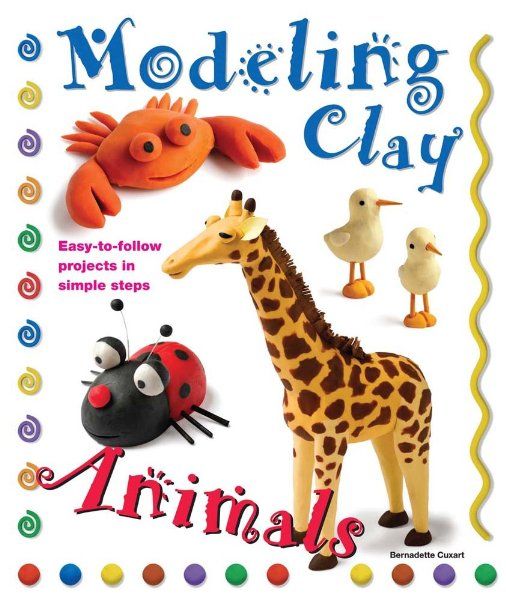Welcome to the wonderful world of clay crafting! If you're looking for a creative outlet that combines both artistry and fun, you’ve picked the right place. Clay is a versatile material that allows you to give life to your imagination. Whether you're a seasoned artisan or a curious beginner, there’s something absolutely enchanting about molding, shaping, and creating with clay. Let's dive into what makes clay crafting so special and how you can get started with some simple techniques!
Choosing the Right Type of Clay for Your Project

Before you roll up your sleeves and get those creative juices flowing, it’s important to choose the right type of clay for your project. With so many options available, each type of clay has its own unique characteristics and uses. Here's a rundown of the most common types of clay to help guide your choice:
- Air-dry Clay: This clay is perfect for beginners and doesn't require a kiln. It dries naturally, making it a convenient option for those who want to create with ease. It’s ideal for decorative pieces, simple sculptures, or kids' crafts.
- Polymer Clay: This is a type of synthetic clay that you can bake in your home oven. It's great for detailed projects like jewelry, figurines, and other small crafts. Once hardened, polymer clay is durable and can be painted or sealed.
- Pottery Clay: If you’re looking to make functional pieces like bowls or mugs, this is your go-to clay. Pottery clay needs to be fired in a kiln, which requires access to proper equipment. This type of clay can be a bit advanced but offers stunning results!
- Earthenware Clay: This is one of the oldest types of clay and is used for pottery and sculpture. It’s fired at low temperatures and is quite porous. This type can be used for both functional and decorative pieces but needs to be glazed if it’s going to hold liquids.
- Stoneware Clay: Known for its toughness, stoneware clay is fired at high temperatures and is often used for creating durable kitchenware. It can be used for both functional and artistic creations and is ideal for serious potters.
Consider the following factors when choosing your clay:
- Project Type: Are you creating a decorative item or something functional? Decide based on what you want to achieve.
- Skill Level: If you're a beginner, starting with air-dry or polymer clay can ease you into the world of clay crafting without the need for complex tools or equipment.
- Availability: Check what clays are available in your local craft store or online. Accessibility is key to starting your project smoothly.
- Finishing Options: Some clays, like polymer, can be painted and sealed after baking, while others may require glazes. Think about how you want your finished piece to look.
Once you've selected the appropriate clay for your crafting needs, you're one step closer to bringing your creative visions to life. The joy of clay crafting lies in experimentation, so don’t hesitate to try different types and techniques as you become more comfortable with your medium. Happy crafting!
Also Read This: Is Dailymotion a Safe Platform? A Comprehensive Guide to Trust
3. Essential Tools and Supplies for Clay Crafting
Before diving into the world of clay crafting, it's important to gather some essential tools and supplies. Having the right equipment not only makes your crafting experience easier but also enhances your creativity. Here’s a handy list to get you started:
- Clay: Start with a good quality clay. Polymer clay is versatile and easy to use, while air-dry clay offers a different texture and consistency.
- Cutting Tools: Use a craft knife or clay cutting tools for shaping and detailing your pieces.
- Rolling Pin: This is perfect for rolling out your clay to an even thickness.
- Clay Sculpting Tools: A variety of sculpting tools can help you create different textures and shapes. Look for ball tools, ribbon tools, and sponge tools.
- Work Surface: Consider investing in a non-stick mat or a dedicated workspace to keep your projects organized.
- Water and Sponge: These are essential for smoothing out your clay and keeping it pliable.
- Oven (for Polymer Clay): If you're using polymer clay, make sure you have an oven to cure your creations according to the manufacturer's instructions.
- Paints and Sealers: Once your project is complete and dried, you might want to add some paint and a sealer to give it a polished look and extra durability.
Don’t forget about storage! Keeping your clay and tools organized will help you stay inspired and ready to craft whenever the mood strikes. A small tool box or a dedicated shelf can work wonders in maintaining your creative space.
Also Read This: Is Dailymotion Free and Safe to Use? An In-Depth Overview
4. Basic Techniques for Working with Clay
Once you have your tools and supplies ready, it’s time to learn some basic techniques for working with clay. These foundational skills will help you create beautiful pieces, whether you're making simple shapes or more intricate designs.
1. Kneading: Just like dough, clay needs to be properly conditioned before use. Kneading helps make the clay softer and more workable. Take a piece of clay and roll it in your hands, pressing down until it loses its stiffness.
2. Rolling: Use your rolling pin to flatten your clay to an even thickness. Aim for about ¼ inch for most projects. This technique is essential for making slabs that you can cut into different shapes.
3. Pinching: For simple forms like bowls or cups, the pinching technique is highly effective. Create a ball of clay, and then press your thumb into the center while pinching the sides with your fingers to shape it.
4. Coiling: Create long, snake-like coils of clay, then stack and blend them together to form intricate pottery or sculptures. This technique is great for creating textured pieces!
5. Slab Building: This method involves rolling out slabs of clay and then cutting shapes to assemble a project. Slab building is great for creating boxes, tiles, or any flat surface designs.
6. Joining Pieces: When combining different pieces of clay, use a little water or scoring (making small cuts in the clay surface) to ensure a strong bond. Remember to blend the edges for a seamless finish.
With these techniques under your belt, you'll be well on your way to creating stunning clay art. Experiment, have fun, and remember that each piece is a unique expression of your creativity!
Also Read This: How to Download Dailymotion Videos for Free and Easily
5. Step-by-Step Guide to Your First Clay Project
Are you ready to dive into the world of clay crafting? Let's take a simple yet fun project that anyone can do—making a cute clay bowl! This project is perfect for beginners, and you can personalize it in countless ways. Grab your clay and let’s get started!
Step 1: Gather Your Materials
- Oven-bake clay (like Sculpey or Fimo)
- Rolling pin
- Cutting tool (a knife or a sharp blade)
- Baking sheet
- Parchment paper
- Your hands!
Step 2: Prepare Your Work Surface
Start by clearing a clean, flat area to work on. It’s helpful to cover your surface with parchment paper to prevent sticking and make cleanup easier.
Step 3: Condition the Clay
Break off a chunk of clay and start kneading it in your hands. This process, called conditioning, warms the clay up and makes it more pliable. You’ll know it’s ready when it feels smooth and is easy to shape.
Step 4: Roll Out the Clay
Using your rolling pin, roll out the clay to about ¼ inch thick. Feel free to add texture by pressing objects (like fabric or leaves) into the clay. This can give your bowl a unique look!
Step 5: Shaping the Bowl
Now comes the fun part! Cut a circle from your rolled-out clay. You can use a bowl or a cookie cutter as a guide. Once you have your circle, gently lift it and place it inside an oven-safe bowl to shape it into a bowl form. Press it down gently but firmly, making sure to smooth the edges.
Step 6: Add Details
Here’s where you can let your creativity shine—add designs or patterns! You can carve lines or use stamps to add lovely textures. If you want to create a decorative edge, roll out small coils of clay and press them around the rim.
Step 7: Bake Your Bowl
Check the instructions on your clay package for the exact baking temperature and time. Place your bowl on a baking sheet lined with parchment paper and bake it in the oven. Remember to keep an eye on it!
Step 8: Cool and Finish
Once baked, allow your creation to cool completely before handling it. You can paint or seal your bowl with a clear coat to give it a polished finish. And just like that, you’ve created your first clay masterpiece!
Also Read This: How to Adjust the Volume on Dailymotion for Better Viewing
6. Tips for Baking and Finishing Your Clay Creations
Now that you've crafted your clay project, it's crucial to understand the baking and finishing process. This part can make or break your creation, so let’s dive into some handy tips to ensure everything turns out beautifully!
Tip 1: Follow Instructions
Always refer to the packaging instructions for the specific brand of clay you’re using. Different brands may have different baking times and temperatures, so adhering to these guidelines is essential for avoiding any mishaps.
Tip 2: Use a Convection Oven (if possible)
If you have access to a convection oven, use it! Convection ovens provide more even heat distribution, which is ideal for baking clay projects.
Tip 3: Avoid Overbaking
Overbaking can lead to discoloration or unwanted brittleness. Keep a close eye on your piece and check for readiness a few minutes before the suggested baking time ends.
Tip 4: Let It Cool
After baking, allow your clay piece to cool down completely before you touch it. It helps to prevent any accidental breakage or smudging of details you added.
Tip 5: Sanding for a Smooth Finish
If your creation has rough edges, you can use fine-grit sandpaper to smooth them out after cooling. Just be gentle and patient!
Tip 6: Painting and Sealing
To add color to your creation, acrylic paint works wonderfully! After painting, consider sealing the piece with a clear acrylic sealer for long-lasting durability and a glossy finish.
Tip 7: Explore Other Finishing Techniques
You can experiment with other finishes as well, such as decoupage or adding embellishments like beads or fabric pieces. Don’t hesitate to get creative—this is your unique piece, after all!
By keeping these tips in mind, you'll be well on your way to crafting beautiful, durable clay creations that you can cherish or gift. Let your imagination run wild, and most importantly, have fun with it!
Also Read This: How to Design Textiles in Photoshop: Easy Step-by-Step Video on Dailymotion
7. Advanced Clay Techniques for Experienced Crafters
If you’ve mastered the basics of clay crafting and find joy in molding, shaping, and creating, it might be time to explore some advanced techniques that can elevate your work to new heights. Here are a few methods to consider:
- Raku Firing: This ancient technique involves removing pottery from a kiln while it’s still hot and placing it in combustible materials to create unique surface effects. The unpredictability of raku firing results in beautiful, one-of-a-kind pieces.
- Texturing: Get creative with textures! Use natural items like leaves or fabric to impress designs into your clay. This adds a unique touch to your creations, making each piece stand out.
- Layering: Experiment with layering different colors of clay. You can create beautiful gradients or even patterns by rolling out thin sheets of colored clay and layering them before cutting out shapes.
- Inlay and Resist Techniques: Use contrasting colors of clay for inlays, allowing you to create intricate designs. A resist technique, where you cover parts of your piece to protect it during glazing, can lead to stunning visual effects.
- Mixed Media: Don’t be afraid to combine clay with other materials such as wood, metal, or fabric. This adds depth and interest to your projects, making them more dynamic and visually appealing.
- Advanced Sculpting: Dive into character design or realistic figurines. Focus on proportions and details to bring your sculptures to life. Don’t forget to use tools like fine brushes or metal sculpting tools for exquisite detailing!
With these advanced techniques, the sky’s the limit! Experiment and allow your creativity to flow. Remember, each new method you try adds layers of skill and enhances your clay crafting journey.
Also Read This: How to Make Flowers with Ribbon on Dailymotion
8. Inspiration and Ideas for Clay Projects
Staring at a block of clay can sometimes be daunting, especially when inspiration seems to evade you. Fear not! Here are some fun ideas and themes that might spark your next clay project:
Functional Items
- Ceramic Mugs: Create personalized mugs using your favorite shapes and designs. Consider adding handles or unique patterns.
- Planters: Craft beautiful plant pots that suit your home decor. You can add drainage holes for practicality and embellish them with interesting textures.
Decorative Pieces
- Sculptures: Let your imagination run wild! Sculpt animals, abstract shapes, or even miniatures of your favorite characters.
- Wall Art: Make small tiles and arrange them into a larger art piece. You can also create a mosaic using broken pieces from previous projects.
Themed Projects
- Seasonal Crafts: Create themed decorations for holidays like Christmas ornaments, Halloween monsters, or spring florals.
- Functional Jewelry: Design unique bracelets or necklaces using clay beads. You can paint them to add an extra touch!
When seeking inspiration, don’t forget to browse platforms like Pinterest or Instagram where you’ll find a plethora of ideas shared by other artists. Remember, crafting is about having fun and expressing yourself, so let your creativity shine!
Now that you have some advanced techniques and inspiring ideas under your belt, it’s time to grab that clay and get crafting. Who knows what incredible creations you’ll come up with next?
Also Read This: Mastering Eyeliner Application Through Dailymotion Tutorials
9. Where to Find Tutorials and Resources Online
If you're diving into the world of clay crafting, you're in for a treat! While getting started can feel a bit overwhelming, the good news is there are countless resources available online to help guide you through the entire process. Here’s a list of some fantastic places to check out:
- YouTube: This platform is a goldmine for visual learners. You can find a variety of channels dedicated to clay crafting that cover everything from basic techniques to advanced projects. Just search for terms like "polymer clay tutorials" or "air-dry clay projects" to get started!
- Blogs and Craft Websites: Many talented crafters share their knowledge through detailed blog posts. Websites like Craftsy, The Happy Magpie, and Arts & Crafts often feature tutorials with step-by-step instructions and stunning visuals.
- Online Classes: Platforms like Skillshare and Udemy offer structured courses on clay crafting. These can range from beginner basics to specialized techniques like sculpting or pottery.
- Social Media: Follow hashtags like #ClayArt or #PolymerClay on Instagram and TikTok. You’ll find not only tutorials but also inspiration from talented crafters around the globe.
- Facebook Groups and Online Communities: Joining these groups can provide you with instant support and feedback. Members often share tips, ask questions, and showcase their creations!
Don't forget to engage with the community! Many crafters are more than happy to answer questions or give advice on your projects. Plus, sharing your own progress can be a great source of motivation. Remember, every expert was once a beginner, so embrace the learning curve and enjoy the journey of creating with clay!
10. Conclusion and Final Thoughts on Clay Crafting
As we wrap up our simple guide to creating with clay, it's essential to reflect on the joy and satisfaction that clay crafting can bring. Whether you're sculpting a tiny figurine or building a beautiful pot, there’s something incredibly fulfilling about working with your hands to bring your imagination to life.
In conclusion, here are a few key takeaways to keep in mind as you embark on your clay crafting journey:
- Start Simple: It’s easy to get carried away with complex projects, but starting with simple creations will help you build confidence and technique.
- Practice Regularly: Like any skill, practice makes perfect. Set aside time each week to experiment and refine your craft.
- Don't Fear Mistakes: Some of the best learning experiences come from trial and error. Embrace imperfections as part of the creative process!
- Connect with Others: The clay crafting community is filled with passionate individuals. Don’t hesitate to seek inspiration and share your work!
- Have Fun: The most important aspect of crafting is to enjoy the process. Let your creativity flow and find joy in every piece you create.
Remember, every creation tells a story and is a reflection of your unique style. Clay crafting is not just a hobby; it’s a form of expression that can be both therapeutic and rewarding. So, gather your materials and let your imagination take the lead. Happy crafting!
 admin
admin








